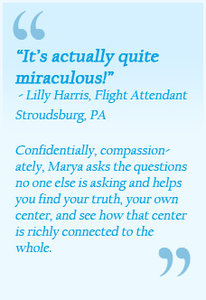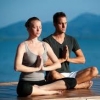Touch, Yoga, & Yogassage

Self-adjustments, partner assists, and acu-yoga — yogassage — can be, quite literally, touchy subjects. Yet using our hands, minds, and loving touch to deepen awareness in yoga is enormously beneficial.
Entering yoga, we start by feeling what is. We simply tune into the body and focus awareness on how we are. Spirit, thought, emotions and sensations flow through the flesh, just as they are. With complete acceptance, we bring all of it – pains, loves, hurts, and pleasures: our whole selves — to the mat.
This offering of acceptance is the first key step in yoga. We befriend ourselves. Muscles relax, organs open, and fluids reconnect us to the one flowing, the one web of life.
This offering of the Soul to the Oversoul is the most fundamental self-adjustment. By choosing to move away from the frenzied world, ego demands, inner agitations and criticisms, and absorb ourselves into a state of compassion and positive regard, we evolve our higher selves.
Depending on our progress, the physical practice of yoga can extend out to be a template for all our relationships.
A second key step in yoga learning is to use our own hands to adjust poses. Simply placing a right hand on the left ear and tilting the right ear toward the right shoulder with a little traction stretches the left side of the neck and meridians in a nourishing way. Instructing a student to bring awareness to the angle of her pelvis by placing her hands on her hips and physically feeling it is another way to self-adjust.
A third step is the use of gentle, hands-on assistance by teachers or partners that can help deepen a twist, stabilize a balance, and lengthen inversions. The right touch gives your partner a lovely feeling of spaciousness and release. Stable support in poses like Ardha Chandrasana, or Half Moon Pose, can liberate more subtle actions in the pose.
Always ask someone before you touch them unless you have a pre-arranged agreement that it’s okay. One reason that hands-on adjustments and all physical contact have become such “touchy” subject is that people sometimes think it’s their prerogative to touch someone when it’s really not; it can be a violation of that person’s personal space boundary.
We live among many touchy-feely kinds of people – I am definitely one of them – so it’s doubly important to remember to ask permission before touching, massaging, or even hugging someone. Just because it’s okay for us doesn’t make it okay for others. Even with those you know are touchy-feelies, there may be days they don’t want to be touched. Be respectful and ask.
That said, one of the most loving introductions to a new friend came in Telluride, Colorado, when he sat down on a sofa where I was sitting with my legs up and started massaging my feet. Without a word, we embarked on a lifelong mutuality and caring.
The variance between that wonderful experience and another event, when a friend came up behind me, and without warning put his hands on the sides of my head to start tilting it left and right, was remarkable. Coming from behind without forewarning and literally gripping my head made this friend’s touch irritating and uncomfortable. How could he think he had the right to start manipulating my body, by surprise?
What made the radical difference? The first contact was in front of my eyes and to my feet, a very “touching” place, with a sense of service. I could have averted his gesture with a simple shake of my head. The second contact came from behind my back and touched a very sensitive area, my temples, ears, and jaws, and felt like someone was trying to “fix” me.
The main takeaway is that everyone is different. And it’s all okay. Ask. Be sensitive. Be clear. Know your boundaries and respect others’ boundaries.
And in a yoga class, always ask permission first.
————————————————
For more information, to comment, or to sign up for the upcoming Yogassage Seminar, please contact Dr. Marya Mann here
Find more detail about the Yogassage Seminar by clicking here: Yogassage


